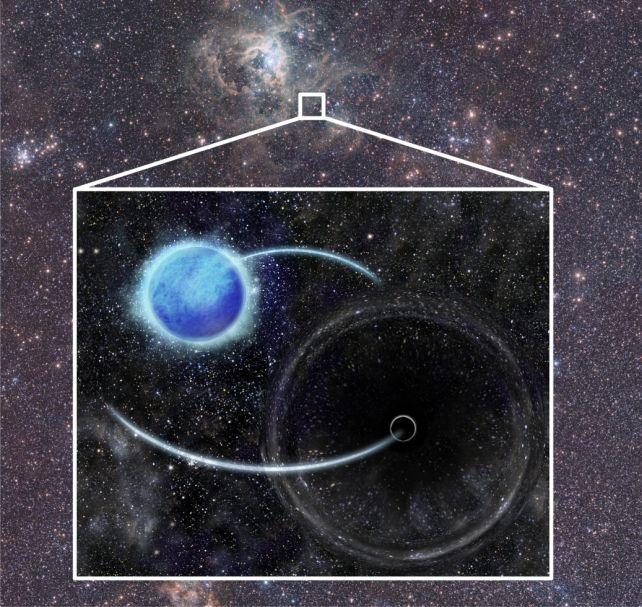ARTICLE AD
When massive stars die, as we understand the Universe, they don't go quietly. As their fuel runs out, they become unstable, wracked by explosions before finally ending their lives in a spectacular supernova.
But some massive stars, scientists have found, have simply vanished, leaving no trace in the night sky. Stars clearly seen in older surveys are inexplicably absent from newer ones. A star isn't exactly a set of keys – you can't just lose it down the back of the couch. So where the heck do these stars go?
A new study has given us the most compelling explanation yet. Some massive stars, suggest an international team led by astrophysicist Alejandro Vigna-Gómez of the Niels Bohr Institute in Denmark and the Max Planck Institute for Astrophysics in Germany, can die, not with a bang, after all, but a whimper.
Their evidence? A binary system named VFTS 243 in the Large Magellanic Cloud, consisting of a black hole and a companion star. This system shows no signs of a supernova explosion that, according to our models, ought to have accompanied the formation of the black hole.
 A not-to-scale artist's impression of the VFTS 243 system and its home in the Tarantula Nebula. (ESO/M.-R. Cioni/VISTA Magellanic Cloud survey/Isca Mayo/Sara Pinilla)
A not-to-scale artist's impression of the VFTS 243 system and its home in the Tarantula Nebula. (ESO/M.-R. Cioni/VISTA Magellanic Cloud survey/Isca Mayo/Sara Pinilla)"Were one to stand gazing up at a visible star going through a total collapse, it might, just at the right time, be like watching a star suddenly extinguish and disappear from the heavens," Vigna-Gómez explains.
"The collapse is so complete that no explosion occurs, nothing escapes and one wouldn't see any bright supernova in the night sky. Astronomers have actually observed the sudden disappearance of brightly shining stars in recent times. We cannot be sure of a connection, but the results we have obtained from analyzing VFTS 243 has brought us much closer to a credible explanation."
When a star more massive than about 8 times the mass of the Sun goes supernova, it's extremely messy. The outer layers – most of the star's mass – are explosively ejected into the space around the star, where they form a huge, expanding cloud of dust and gas that lingers for hundreds of thousands to millions of years.
Meanwhile, the star's core, no longer supported by the outward pressure of fusion, collapses under gravity to form an ultradense object, a neutron star or a black hole, depending on the initial star's mass.
These collapsed cores don't always stay put; if the supernova explosion is lopsided, this can punt the core off into space in a natal kick. We can also sometimes trace the core's trajectory back to the cloud of material it ejected as it died, but if enough time has elapsed, the material may have dissipated. But the signs of the natal kick can remain a lot longer.
frameborder="0″ allow="accelerometer; autoplay; clipboard-write; encrypted-media; gyroscope; picture-in-picture; web-share" referrerpolicy="strict-origin-when-cross-origin" allowfullscreen>
VFTS 243 is a very interesting system. It consists of a massive star that's around 7.4 million years old and around 25 times the mass of the Sun, and a black hole around 10 times the mass of the Sun.
Although we can't see the black hole directly, we can measure it based on the orbital motion of its companion star – and, of course, we can infer other things about the system.
One interesting thing is the shape of the orbit. It's almost circular. This, together with the motion of the system in space, suggests that the black hole did not receive a huge kick from a supernova. The researchers who discovered the black hole back in 2022 suspected as much; now, the work of Vigna-Gómez and his colleagues have confirmed it.
There has been a growing body of evidence that suggests that sometimes, massive stars can collapse directly into black holes, without passing supernova or collecting 200 space dollars. VFTS 243 represents the best evidence we have for this scenario to date.
"Our results highlight VFTS 243 as the best observable case so far for the theory of stellar black holes formed through total collapse, where the supernova explosion fails and which our models have shown to be possible," says astrophysicist Irene Tamborra of the Niels Bohr Institute.
"It is an important reality check for these models. And we certainly expect that the system will serve as a crucial benchmark for future research into stellar evolution and collapse."
The research has been published in Physical Review Letters.

 7 months ago
51
7 months ago
51 

